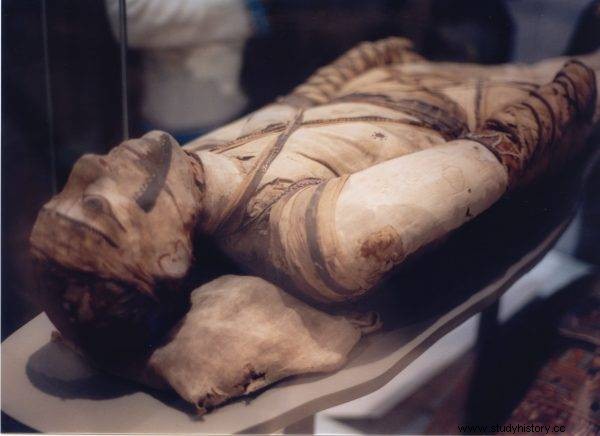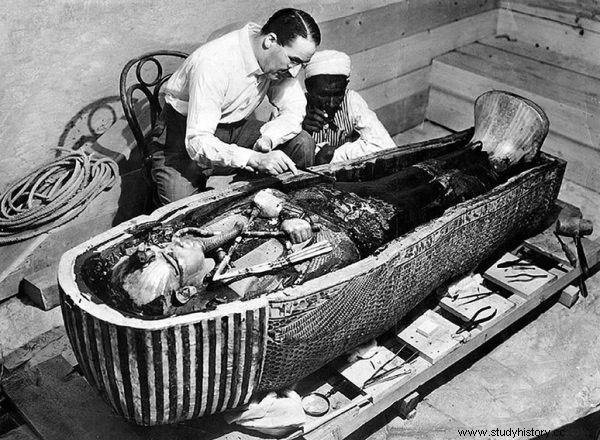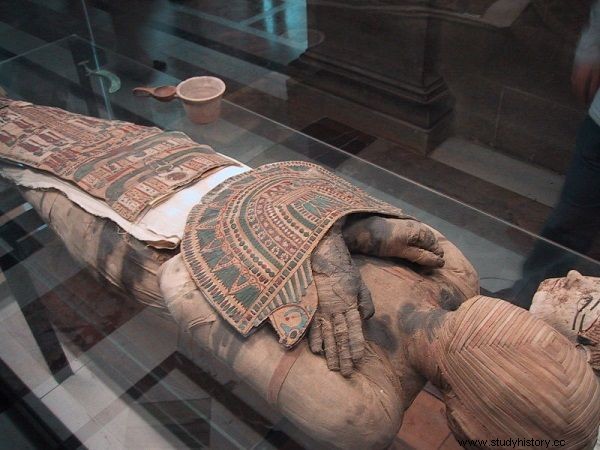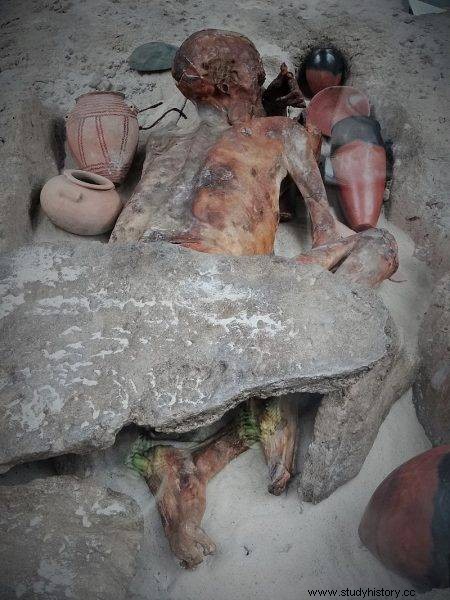What medicine for bruises was used by the king of France, Franz I Valois? What could not be missing from the first aid kit of the English monarch Elizabeth I? Of course ... a powdered Egyptian mummy!
It is said that the mummy was used for medical purposes for the first time in the 12th century by a doctor from Alexandria , Arab-Jewish descent - El-Magar. He prescribed this specific drug to his patients as a panacea for contusions and wounds.
History of a certain mistake
Medicines made on the basis of embalmed bodies found their way to pharmacy shelves as a result of a rather macabre misunderstanding (after all, acquiring mummies for medicinal purposes is profanation). All because of the similarity of the black color of the prepared corpse and the color of a substance called mummija .

Mummy. The powdered version is a panacea for everything
The bodies of the deceased Egyptians took on their dark color as a result of the action of embalming resins, which were believed to have bactericidal properties. Meanwhile, a mysterious drug called mummija (the term was used by the Arabs) is bitumen.
This viscous, petroleum-based liquid made of a mixture of organic substances has been widely used in medicine. Bitumen occurs naturally in various types of sedimentary rocks, and is also obtained from fossil coal, oil shale and a specific type of crude oil distillation. In the Oriental world, bitumen has for many centuries been considered a means of healing power.
The Persian scientist, philosopher and physician Ibn Sina (known more widely as Avicenna) prescribed bitumen, among others for dizziness, stomach discomfort, rashes, sore throat, poisoning, nausea. On the other hand, the Arab writer Abd el-Latif of the 12th century argued that mummija can be used in two ways:inhaling and ingesting orally.
The belief in the effectiveness of bitumen lasted until the nineteenth century, when the Persian Shah sent Queen Victoria a gift sample of bitumen. His activities on sw

Howard Carter would probably have found many more valuable mummies in Egypt, had it not been for some macabre mistake ...
Crusaders could also experience her skin. In Palestine, Jewish medics applied medicine to cuts and bone fractures.
The development and consolidation in the minds of entire societies of the erroneous view that the blackened mummies extracted from Egyptian sarcophagi do not differ in any way from bitumen should be attributed to Gerard of Cremona. This 12th century translator of Arabic works concluded that the mummy was nothing but:
[… ] a substance from a country where the bodies are treated with aloe, with which the fluids of the deceased mix, transforming into something similar to ship tar . (quoted after:J. Molenda, "Mummies. The phenomenon of cultures")
For many centuries, no one verified this position, which contributed to the true hunting of Egyptian mummies.
The drug almost does everything
In order for the embalmed body to be suitable for consumption as medicine, it had to be properly prepared first. The mummies were ground and then mixed with various herbs (e.g. thyme, elderberry, marjoram). King Francis I of Valois had his own individual recipe:he combined a loose corpse with rhubarb.
Ointments for bruises were also prepared from the mummy. In this case, the bodies were boiled and rendered fat was used for medical purposes.

I'd like a powdered hand, please. It will be just right for that lumbago!
Medicines based on the bodies of the inhabitants of the ancient world had many uses. The English philosopher Francis Bacon praised their ability to staunch blood. On the other hand, a botanist of German origin, Adam Lonicer, recommended the use of the mummy in cases of:scorpion bites, urinary tract ailments, hypochondria or hemorrhages.
Of course, to prepare the medicines you had to get the right mummies . How to choose the best one is mentioned in his medical dissertation from 1694 by Pierre Pomet:
It should be black, without sand, and must have a pleasant smell - not tar or resin, but burnt. (quoted after:J. Molenda, "Mummies. The phenomenon of cultures")
Expeditions for valuable goods and shortcuts
Sixteenth-century inhabitants of European cities were overwhelmed by a real mumomania, and a powder made from mummified remains became the most fashionable medicine . Therefore, every self-respecting pharmacist at the time had to have it in his store.
Due to the high demand for this eccentric drug, many European daredevils did not hesitate to do anything to get the desired goods in the land of the pharaohs.

Had Ramses II been found two centuries earlier, he might have ended up as an ointment ...
The Chaplain of Catherine of Medicine - André Thévet in 1549 plundered the necropolis in Saqqara. The representative of the Turkish Company, Sir John Sanderson, who came to Egypt in 1586, went even further. Jarosław Molenda reveals the secrets of his expedition:
Upon arrival, he saw sand dunes covered with a tangle of bones and bandages. The newcomer discovered the tomb to which he descended on the rope, and in great excitement he began his "research":
"I was tearing off body parts to see them become a medicine" - he later wrote - "[...] I took home more than one head, hand, arm and foot." After bribing the customs officers, he loaded the "goods" onto a ship bound for England .
As it turned out, Sir John Sanderson managed to send 600 pounds of powder prepared from embalmed corpses to the Islands and one whole mummy. He sold his prey with a great profit. The trade in mummies turned out to be so lucrative that they began to be fabricated over time . Guy de la Fontaine, a French physician of the King of Navarre, encountered such fakes in 1564.

Egyptian mummies in the British Museum
After arriving in Alexandria, in the largest store, the medic saw a large pile of mummies. His vigilant nose was not deceived, however, and after talking to the seller it turned out that none of the mummies were more than 4 years old. You have to admit:first freshness merchandise! However, the true masters at counterfeiting mummies were according to Molenda, Jewish traders :
They bought the bodies of executed criminals or people who died in hospitals - both Christians and followers of other religions - they smeared the body and limbs with tar, then they tied the body for several years they buried them shallowly in the ground in a mass grave, exposing them to high temperatures. After this "treatment", the bodies did resemble ancient mummies. (quoted after:J. Molenda: Mummies. The phenomenon of cultures )
The belief in the healing properties of mummy was so deeply rooted that in the middle of the 19th century in Central Europe, medics prescribed mummy powder to patients . Interestingly, even William Shakespeare succumbed to the prevailing mumiomania. In "Macbeth", the witches brew a magic soup in a cauldron with the addition of an important ingredient - mummy:
The swampy snake's jaw
Let it simmer:
Frog's eye, hedgehog paws,
Dog's mouth and bat's down,
Viper sting, lizard head,
Owl flight and rat tail,
Let it all pile up
He brews in this hellish soup.
A few more ingredients!
Dragon's scales and wolf's tooth,
Mummy's juice , intestines and saliva
Sea robbers, sharks,
Root of henbane and hemlock
Spewed out from the womb of the earth into the night, (...)
